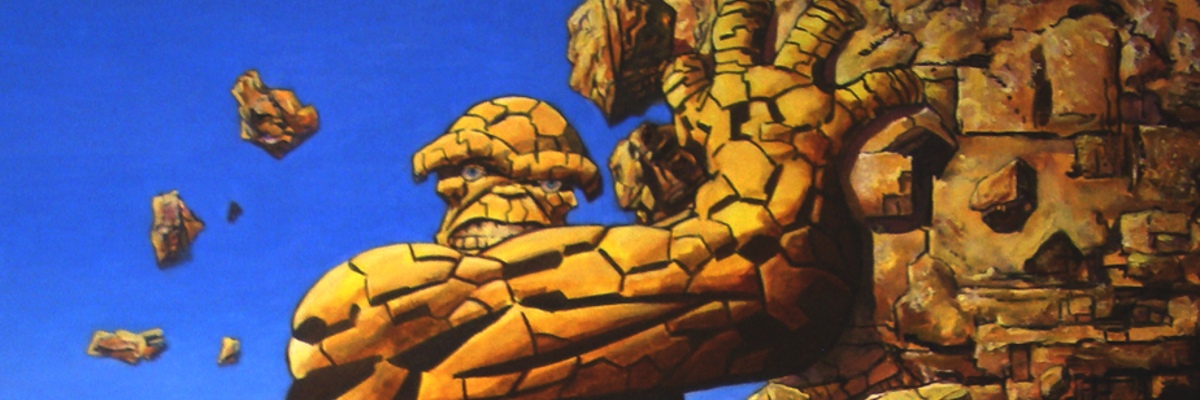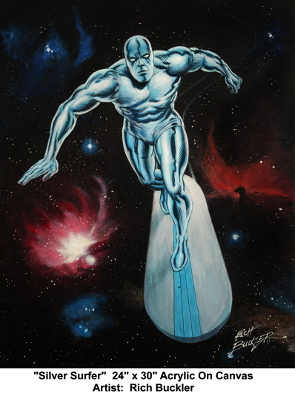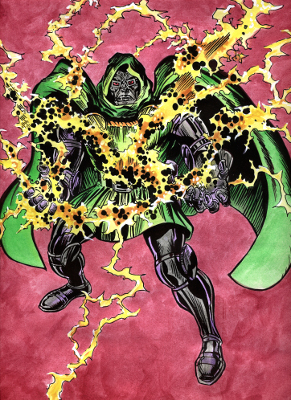Interview with Rich Buckler
Originally published February 2007

"I don't understand why anybody got the idea that comics had to 'grow up' or that they had to aim at a specific market. It's a mistake."
Artist Rich Buckler was behind 21 issues from 1974-1976, and came back for a further 8 issues and an annual in 1989. Add to this two issues of Giant Size Fantastic Four, and he's a man with a lot of experience when it comes to illustrating the group. He kindly gave an interview with the site in February 2007, as well as sharing some of his new art. For this reason, an interview on Headquarters isn't illustrated by panels from the comic book itself, but Rich's new work with the characters.
Rich, thank you for agreeing to answer a few questions about your time on The Fantastic Four. Looking at your personal website, I initially wasn't sure that you were the same person as you've moved into extremely impressive surreal art. How is the new direction currently going, and what inspired you to make the break away from illustrations?
Actually, it's not a “new direction,” but rather an extension of what I've been doing. About seven years ago it became evident to me that the time arrived for me to start painting. It was more of an evolutionary step—and one that I'm glad I took!
While you first began at DC in 1967, I gather it was the co-creator of the FF, Jack Kirby, who was instrumental in getting you your first big break?
 No, the first break came at D.C. Comics, but it was Neal Adams and Dick Giordano that made that happen. Jack's recommendation did land me my first assignment at Marvel about a year later (with Stan Lee as the writer, no less!). I remember, too, getting one of my first assignments for one of Marvel's horror/supernatural titles. It was a back-up feature, a haunted house type of thing. What made it memorable was that I had met Jim Steranko at the Marvel offices just a day or two before. The writer of that assignment, as it turned out, was a young lady totally enamoured of Jim (but no longer dating him). Her and I got together for a lunch to discuss the story--but almost all she did was talk about Jim! It's funny, because I took that assignment with an idea that I could try a storytelling approach that was very much inspired by Jim Steranko (well, it was my version of what I thought Jim would do). So, anyway, I didn't get to draw super-heroes right away, let alone main features or a full book (you had to work your way up to that--and I was such a young snot!). At the same time (or, rather, during that same time period) I was doing work for Archie Goodwin at Warren Publishing (Creepy & Eerie), and D.C. Comics (back-up stories for Lois Lane, and then "Robin" back-up features in Batman). I don't know how I kept up with it all, but I did!
No, the first break came at D.C. Comics, but it was Neal Adams and Dick Giordano that made that happen. Jack's recommendation did land me my first assignment at Marvel about a year later (with Stan Lee as the writer, no less!). I remember, too, getting one of my first assignments for one of Marvel's horror/supernatural titles. It was a back-up feature, a haunted house type of thing. What made it memorable was that I had met Jim Steranko at the Marvel offices just a day or two before. The writer of that assignment, as it turned out, was a young lady totally enamoured of Jim (but no longer dating him). Her and I got together for a lunch to discuss the story--but almost all she did was talk about Jim! It's funny, because I took that assignment with an idea that I could try a storytelling approach that was very much inspired by Jim Steranko (well, it was my version of what I thought Jim would do). So, anyway, I didn't get to draw super-heroes right away, let alone main features or a full book (you had to work your way up to that--and I was such a young snot!). At the same time (or, rather, during that same time period) I was doing work for Archie Goodwin at Warren Publishing (Creepy & Eerie), and D.C. Comics (back-up stories for Lois Lane, and then "Robin" back-up features in Batman). I don't know how I kept up with it all, but I did!
Looking back through the Fantastic Four issues you were given to work on, one thing that both runs have in common is that hardly any of them feature the full core group. Your first issue was the one after Sue walked out, and while there's three issues in '75 with the full team, soon after that Ben loses his powers and gets replaced. With the 1989 run, the majority of the issues feature “clones”, while the real FF have dream sequences. Did you ever wish that you'd been given the core team to play with for longer?
That never bothered me. Well, the female version of The Thing in the 80's run was not one of my favorites. There haven't exactly been any clamors from comics readers to bring her back. For me, it was a dream come true to be drawing this book. I wish I could get a crack at a decent run on the Fantastic Four now--that would be really cool.
The '70s period saw a frequently changing line-up on the art side of things - in '76 there was you, John Buscema and George Perez all working on the title, on one occasion even on the same issue. Although all three of you had your own individual styles, they also complimented each other and didn't clash. Was this a conscious effort of all three, or just a happy coincidence?
It was probably coincidence, mostly. But a lot of that "continuity of style" had to do with Joe Sinnott's inking (which was always outstanding) for the 70's stuff. I was mostly drawing pencilled pages, but I desperately wanted then to learn how to ink my own work (I mean, of course I already knew how, and I could work in ink--but, I mean, inking my own pencilling more confidently and consistently). Joe Sinnott's "secret" (if he has a secret!) is that he is a terrific artist! He's known for his inking, but the guy's drawing ability is amazing. Anyway, I remember from those days when inked pages of mine would come into the editorial office, I would photocopy them and I was always amazed at what magic Joe had worked on them! He didn't just trace over my lines in ink--he literally improved everything!
All three are personal favourites of mine - I gather that George Perez actually began his career as your assistant?
Yes, he did. Probably every artist at Marvel was influenced by Jack Kirby, though. George was no exception. You can see it in his earliest work. However, I would like to point out that none of my work was "drawn by assistants." I worked for Gil Kane as his assistant (so did Howard Chaykin), and we never got to actually draw anything for him. Assistant means just that--you're there to assist.
Your work on the book, especially on your first run, was characterized for me by really vibrant, dynamic and muscular characters. Probably the most remarked upon aspect is also that while in your own individual style, it also was reminiscent of Kirby. Was this a conscious homage while you were working on the title?
That was partly due to the level of my drawing ability at the time, and my preferences for dynamic storytelling and action in Super-Hero comics (which always favored Jack Kirby and John Buscema). I couldn't draw (yet) at John Buscema's level, but I thought--hey, I can sure give it a good shot to try to capture those Jack Kirby dynamics!
Apart from a couple of odd issues, the majority of the 70s work was done with two writers - Gerry Conway and Roy Thomas. How did you find working with the different styles of both?
I didn't notice a big difference. Both writers were a pleasure to work with.
In many ways with the threat of Reed and Sue's divorce hanging over most of the 70s issues you worked on, it's the title's first real step away from the core child audience. There was also the politically conscious Power Man appearing in the issues, and even Stan was writing stories about drug addiction for Spider-Man around this time. Was it especially notable at the time that comics seemed to be getting more sophisticated throughout the 70s?
The comics were still pretty naive back then, I think, anyway. Writers and artists were growing up, along with the readership, so naturally the content of the comics was going to reflect that. Nobody was issuing any editorial directives that called for more adult material, and there was no clamour for "social consciousness" or stories that were "relevant" or realistic (as in imitating real life, or taking on current affairs, or anything like that).
Perhaps the most controversial element of your first run was a trio of issues featuring “Mahkizmo”, in a satire of gender politics. Perhaps the most notable element of which was The Thing describing Thundra as a “nutty refugee from a women's lib meetin'”. Although humorous to look back on, is this, in hindsight, a story you'd perhaps have had second thoughts about taking part in today?
 That comment by the Ben Grimm of the 70's would probably be made by Ben Grimm today, even. But we're talking satire here, really. It was in Ben's character that he would perceive a strong woman as threatening. The other members of the FF, as I understood the characters, didn't necessarily have the same slant on things. They were each different personalities, with distinctly different--and sometimes opposing-- character traits. That, I think, is what made the book work. It was a team book, but each individual in the group had his/her take on things.I don't think anybody yet has pointed out how the F.F. evolved, evidently, from the idea of the "four elements" of hermetic science--you know, earth, air, fire and water. Think about it: The Thing was earth (bulky, heavy, mineral-like), Human Torch was fire, Invisible Woman was air (like our atmosphere, which can't be seen--or gas, a substance that has mass but is also unseen) and Mr. Fantastic was water (well, like water, anyway--liquid, amorphous, shape-changing, adaptable, etc.). The concept works-- with the four elements providing the fifth element (the individual elements combining into a sort of all-powerful force that made each of them "fantastic").This was applied to developing the personalities of each of the characters, too. Ben was always earthy in his speech and actions. Reed was flexible and open to new possibilities and challenges, his knowledge base always evolvng and changing. Johnny was volatile and impulsive. Sue was very passive but always nurturing.The character I always thought was the weakest was Sue Storm. That's why Stan developed the "invisible force-field" to amplify her power (actually, invisibility was a sort of "non-power" and made her seem too passive). With her new abilities, to my mind, she actually became almost more powerful than the others (though I don't think that's what Stan had in mind, nor is it how readers perceived it). Still, in the stories she was too often cast in the role of "helpless female," which bothered me a lot because it was so stereotyped. There were kinks in each of the characters which subsequent writers seemed to work out satisfactorily.
That comment by the Ben Grimm of the 70's would probably be made by Ben Grimm today, even. But we're talking satire here, really. It was in Ben's character that he would perceive a strong woman as threatening. The other members of the FF, as I understood the characters, didn't necessarily have the same slant on things. They were each different personalities, with distinctly different--and sometimes opposing-- character traits. That, I think, is what made the book work. It was a team book, but each individual in the group had his/her take on things.I don't think anybody yet has pointed out how the F.F. evolved, evidently, from the idea of the "four elements" of hermetic science--you know, earth, air, fire and water. Think about it: The Thing was earth (bulky, heavy, mineral-like), Human Torch was fire, Invisible Woman was air (like our atmosphere, which can't be seen--or gas, a substance that has mass but is also unseen) and Mr. Fantastic was water (well, like water, anyway--liquid, amorphous, shape-changing, adaptable, etc.). The concept works-- with the four elements providing the fifth element (the individual elements combining into a sort of all-powerful force that made each of them "fantastic").This was applied to developing the personalities of each of the characters, too. Ben was always earthy in his speech and actions. Reed was flexible and open to new possibilities and challenges, his knowledge base always evolvng and changing. Johnny was volatile and impulsive. Sue was very passive but always nurturing.The character I always thought was the weakest was Sue Storm. That's why Stan developed the "invisible force-field" to amplify her power (actually, invisibility was a sort of "non-power" and made her seem too passive). With her new abilities, to my mind, she actually became almost more powerful than the others (though I don't think that's what Stan had in mind, nor is it how readers perceived it). Still, in the stories she was too often cast in the role of "helpless female," which bothered me a lot because it was so stereotyped. There were kinks in each of the characters which subsequent writers seemed to work out satisfactorily.
After illustrating over 20 issues in the 1970s, you left the book and got a reputation as the man who'd drawn virtually every major Marvel and DC character. Did it feel strange to return to the Fantastic Four thirteen years later?
It felt different. I was a seasoned professional by then.
Steve Englehart was the first person I interviewed for this site and he claimed that he was using the book at the time you worked on it as a statement about his hatred for what Marvel was becoming. Were you aware of how unhappy he was working on the title at the time, and did it effect your own work?
Honestly... I had no idea. He never talked to me about that.
The last writer you worked with on The Fantastic Four was the very unique Walt Simonson. Although the plot you worked on (the FF in congress) wasn't as far out as some of the later issues he drew himself, how did you find working with Walt?
I didn't get to see Walt very much. The written story plots would come in, the editor would hand them to me and I'd go home and draw up the story. It was understood from the beginning that I was just a "guest" artist on the book. From issue to issue I was always wondering if it were my last one, because they kept reminding me that Walt is going to return to take over pencilling on the book any day now. It was a different Fantastic Four for me--I never got comfortable with it because I was always waiting to get bumped off the book.
Reading modern comics, while they can still be good entertainments, I think there's very much a sense that they're aimed at a niche market - guys like me who read them as a kid and never grew out of the habit. Do you think the fact that the medium doesn't seem to cater for the child audience as much these days is what has led to the overall drop in the market?
That is the drop in the market. The kids are gone. I don't understand why anybody got the idea that comics had to "grow up" or that they had to aim at a specific market. It's a mistake. Where will the new readers come from? The readers, who became fans and collectors, they became the market--and then they became adults. I don't know about you--but with me, comics grabbed me as a kid (and not so much as an adult). Today's distribution and marketing of comics is all screwed up, in my opinion. For artists and writers, it's a disaster. Sales will continue to shrink as long as publishers adhere to this outlandish "publish without risk" scam that is called the comics direct market. But comics are not the only things to suffer from the "economics" of marketing. I don't know what will turn the present situation around--but distribution and marketing are definitely the culprits.
Lastly, if the opportunity came up to work on The Fantastic Four again, would you ever go back?
Yes!
Sadly, Rich passed away in May 2017 aged just 68.